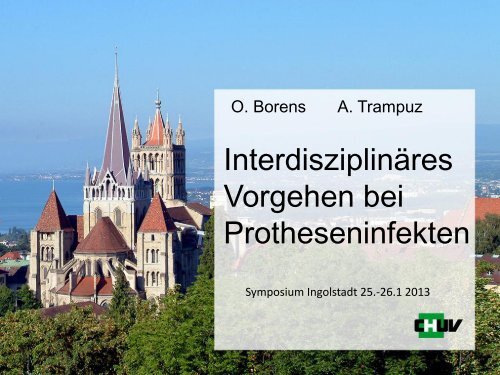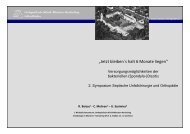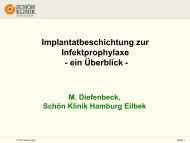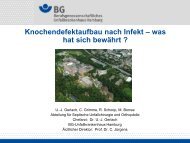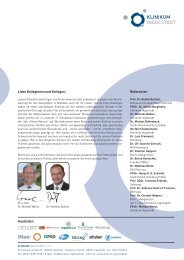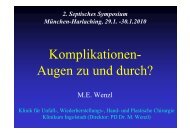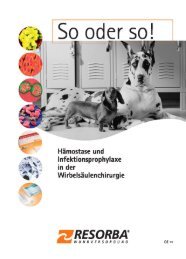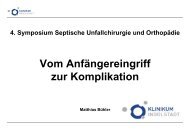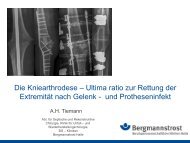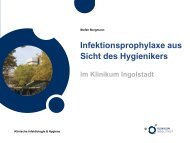3 months! - Septische Chirurgie
3 months! - Septische Chirurgie
3 months! - Septische Chirurgie
- No tags were found...
Create successful ePaper yourself
Turn your PDF publications into a flip-book with our unique Google optimized e-Paper software.
O. Borens A. TrampuzInterdisziplinäresVorgehen beiProtheseninfektenSymposium Ingolstadt 25.-26.1 2013
Or should we do maximaltreatment?• Always aggressive tumor like surgery?• Mutilating surgery for the patient• Amputation
Trampuz A, Borens O. RMS 2011We can have good results!D & RAB 3 mo (+RIF)1-stageAB 3 mo (+RIF)2-stage (2-4 w)2-4 wAB 3 mo (+RIF)2-stage (6-8 w)Infection6-8 wAB 6 w (-RIF)
Concept based on• Team work• Definition• Classification• Diagnostics• Treatment options adapted from case tocase
BacteriostaticBactericidalTETRACYCLINETigecyclinSONSTIGEAzithromycinClindamycinMinocyclinDoxycyclinFusidinsäureOxytetracyclinOXAZOLIDINONELinezolidTeicoplaninNalidixinsäureLIPOGLYCOPEPTIDETelavancinGLYCOPEPTIDEBETALACTAMELIPOPEPTIDEDalbavancinDaptomycinCHINOLONECeftobiprolMoxifloxacinVancomycinLevofloxacinCiprofloxacinCephazolinOxacillinAmpicillinCo-amoxiclavAmoxicillinStreptomycinCephaloridinFlucloxacillinNafcillinMethicillinMupirocinAMINOGLYCOSIDEAmikacinRifampicinGentamicinSONSTIGEPenicillinRolinson GN. Int J Antimicrob Agents. 2007
Antibiotics• Antibiotics are not antiinflammatory drugsand should not be given to make go awayerythema
Frequent errors in systemic AB TT• AB in the wrong way (only oral mono-therapywith AB with low bioavailability: penicillin,cephalosporin)• Rifampicin– No Rifampicin– Rifampicin monotherapy– Rifampicin in open wounds• AB too long (no need for 2y suppressive tx)• AB too short (what is too short?)
Mme D64 yo• ACL rupture in 1980 left knee– Pain and giving waysLeisure sports• Fall 2010: Giving way and important pain– Xray /MRI:• Tricompart. gonarthritis• Medial meniscal lesion• Osteochondromatosis• LCA distended
• 10/06/2011: Arthroscopy (medial mesiscus)• 22/06/2011: Intraarticular injection ofhyaluronic acide, wound drainage 7 dciprofloxacin per os• 27-28/06/2011: Fever, pain, redness,draining pus ongoing oral ciprofloxacin
• 01/07/2011 suspicion of septicarthritis left knee– AS washout– Microbiology: MSSA– AB: 10 days Cefuroxim (2 nd gen. cephalo.) peros– 5 days at hospital• 17/07/2011: Persistant pain, redness,swelling, chills: suspicion of DVT: oralcoumarins
• 17/08/2011: Increasing, invalidating pain(wheelchair bound)X-ray + MRI– Important progression of joint distruction– Free liquidDecision: ad TKA
• 30/08/2011: operation…– Active infection with pus– No TKA– Débridement and lavage– Microbiology: MSSA– AB: Floxapen IV 4x2gr• 01/09/2011: Arthroscopic wash out• 03/09/2011: Arthroscopic wash out
• 24/09/2011: Leaves hospital– After 3 weeks of IV-AB (Flucloxacillin)– CRP 22, LC normal– Oral AB: Levofloxacin + Rifampicin for 6 weeks• 18/10/2011: 2 nd opinion because ofpersistant pain, redness, stiff knee andintermittend fever
• 27/10/2011: First visit at CHUV– Status: scar ok, warm, no redness, effusion,F/E 110/5/0• Proposition?Decision:– Stop AB– Surgical TT with 2 step exchange
Treatment• 09/11/2011: extensivesurgical débridement withsynovectomy, resection ofarticular surfaces,implantation of articulated,AB-loaded spacer• AB prophylaxis amoxi-clav1x2,2gr ivSpacer (Palacos/Genta/Vanco)
Postop treatment• AB: Amoxy-clav. 3x2,2gr iv• FU: Wound ok, lab normal,weightbearing 10-20kg welltolerated• Cultures: sterile two step shortinterval
After 8 days• 17/11/2011: removal of spacer + TKA (LCCK)• Palacos + G/V
Follow up• Microbiology: sterile• Sonication spacer: sterile• Antibiotics: After 1 week stop IV-AB• Levofloxacin 500mg 2xd et Rifampicin 450mg2xd for 6 weeks• Physiotherapy F/E 85/0/0 after 1 week• FU at 3 <strong>months</strong>: CRP
Teamwork!
Definition of implant infection• Sinus tract (fistula)• Purulence– Wound secretion, pus around prosthesis• Acute inflammation in tissue histology– ≥1 to ≥10 neutrophils/high-power field• Leukocytes in synovial fluid 1– Knee: ≥1.7 x 10 9 /l leukocytes, ≥65% neutrophils– Hip: ≥4.2 x 10 9 /l leukocytes, ≥80% neutrophils• Microbial growth– Synovial fluid– ≥3 periprosthetic tissue (for low-virulent organisms >1 positive)– Sonication fluid (>50 CFU/ml)1 Early postoperative (3 <strong>months</strong>) and inflammatory joint diseases excluded
Three types of implant infectionTime0–3 <strong>months</strong> 3–24 <strong>months</strong> >24 <strong>months</strong>TypeEarlypostoperativeDelayed(low grade)LateRoutePerioperativeHaematogenousSignsFever, effusion,warmth, drainagePersistent pain,device loosening,fistulaAcute orsubacuteCauseS. aureusStreptococciEnterococciCoagulase-negativestaphylococciP. acnesS. aureusE. coliZimmerli W NEJM 2004 Trampuz A Injury 2006
Question No. 1A 80 yo patient complains about hip pain, prosthesis isloose. During 1-stage exchange 1 tissue culture wascollected, coagulase-negative staphylococcus grew. Whichinformation helps most for interpretation of the cultureresult?a) Pre- and postoperative CRP levelb) Bacterial species & antimicrobial resistancec) Bone and leukocyte scintigraphyd) Date of arthroplastye) Name of professor’s lawyer
Question No. 1A patient about pain, prosthesis is loos. During 1-stageexchange a single tissue culture grew coagulase-negativestaphylococcus. Which information would you request forinterpretation of the culture result?a) Pre- and postoperative CRP levelb) Bacterial species & antimicrobial resistancec) Bone and leukocyte scintigraphyd) Date of arthroplasty: 10 years agoe) Name of professor’s lawyer
Question No. 267-y: Increasing pain after knee implantation 1 year ago.Which preoperative test most accurately detects infection?a) Serum C-reactive protein (CRP)b) Synovial fluid Gram stain & culturec) Synovial fluid leukocyte count & differentiationd) Conventional x-raye) PET / CT scan
Joint aspirationImportant:1. Native (Gram & Bacteriology)2. Native (Cristals)3. Add EDTA (heparin) fordetermination of cell count (performwithin 24 h) and differenciation4. Inoculation in blood culture bottles
Aspiration of prosthetic knee joints, underlying inflammatory disorders excluded97%94%Trampuz A. Am J Med 2004; 117: 556
Question No. 267-y: Increasing pain after knee implantation 1 year ago.Which preoperative test most accurately detects infection?a) Serum C-reactive protein (CRP)b) Synovial fluid Gram stain & culturec) Synovial fluid leukocyte count & differentiationd) Conventional x-raye) PET / CT scan
Tissue cultureObtain 3 tissue specimens- No swabs, no sinus tract cultures!- Culture sensitivity: 60-80%- Culture specifity: single biopsies false-positive- Prolonged culture incubation 7-14 d(anaerobes/ small colony variants)- Stop antibiotics 2 weeks before- Delay surgical prophylaxis
Planktonic modeBiofilm modeProblem• Diagnostics– With joint aspiration/swabs/tissue cultures wefind planktonic bacteria– We cannot remove biofilm bacteria– Sensitivity is not high enough!
Mr UK 1950 Orthopaedic surgeon• Morbus Parkinson ’01• Stop surgical activity 2004• Rupture achilles tendon:– Op 1/2008
5/2008• Arthroscopy right knee
TKA 7/08 R• Standard procedure• 1,5 gr Cefuroxim• Uneventfull early postop follow up
19.11.08• Important redicular pain L4 with beginningof paretic symptoms– L4 extraforaminal, transpedicularmicrodiscectomy L4/5 left
09.09.2009Invalidating pain L 4 -L 5Ant/Post stabilisation and SI arthrodesis
14.9.2009Fever, Chills, CRP 123Spine• Lumbar drainage of pusTKA R• Slight pain• Warmth• No fluctuationWhat now?
Procedures• Microbiology (Hemoc’s)– Staphylococcus aureus (MSSA)• Spine?• TKA?
TKATherapeutic optionsa. Nihilb. Medical (suppressiv AB’s)c. ASd. Débridement and retention with changing ofmobile partse. 1-step exchangef. 2-step exchange (which interval?)g. Arthrodesis (1-step vs. 2-step)h. Amputation
10.10.2009• Removal TKA and spacer
24.11.2009• Postoperative procedure• Which AB• IV• PO• How long• When to do reimplantation• How to chose the best moment?
Postoperative procedure• Initially: Amoxicillin-Clavulanic acid 2,2gr 3xd• Then Floxapen 4x 2gr iv 6weeks• Reimplantation at 6 weeksQuestion:Stop AB?Preop puncture?Biopsy?Szintigraphy (Pet-CT,…..)?
18.1.2010• Revision total knee– Type of implant– Which prophylaxis and when– AB postop• How long iv and how long po– Which follow up
28.1.2010• Tavanic 500mg2xd• Rifampicin 450mg 2xdQ: Dosage of Rifa?
19.2.2010Ongoing AB; CRP 19
2.3.2010Ongoing AB; CRP 22
22.3.2010• No back pain• Knee is not doing well• CRP around 30
Question• Persistant elevated CRP• Persistant painDiagnostic procedures?
29.3.2010Persistant pain, CRP 22
Stop AB
4.5.2010Neg. biopsy and negativaspirationCRP 18What now?
8.7.2010• Knee arthroscopy with « circumferentialdébridement »
20.7.2011• Arthrotomy with biopsies, circumferentialresection of hypertrophic synovialis andremoval of « dorsolateral neo-meniscus »Indication: Postero-lateral ImpingementBiopsies: Done but sterile
16.8 2011• Patient presents for removal of suturematerial– Persistant swelling of soft tissues– Warmth– Scar ok– CRP 21
5.9.2011Local situation with soft tissue swellingWound okX-ray:Position of implants okNo sign of infection or looseningOssifications around q-ceps tendonAmoxi-clav. po 1gr 2xdCRP 25Redness and swelling due to slow healing
14.11.2011• Patient can walk 1 km• Does better– Persistent warmth of the knee– CRP 16– Stop AB– End of treatment– If problem patient should call
14.12. 2011• Persistant pain, difficulties in walking(needs two sticks!)• Changes orthopaedic surgeon– Function F/E: 30/0/0– Swelling, free liquid, pain, venous insufficency– CRP 34, ESR 18
X-ray
4.1.12• Tap:no growth, no cytology done!
19.1.2012Important synovitis and free liquid, implant loosening
What shall we do?• Next steps– More diagnostics– Operation– Tell patient everything is fine
19.1.2012• Diagnosis: Most likely infection• Options:– 1-step exchange– Arthrodesis– AmputationAd arthrodesis because of soft tissuesituation, bad ROM, Parkinsons’Patient does not want arthrodesisTell patient to go for third opinion
24.1.2012• Tremor left sided• Knee: Swollen, warm, painful• F/E: 80/5/0• CRP 16• Options?– New tap?– Szintigraphy?– Pet-CT?– Surgery?• Preop AB?
30.1.2012• Removal TKA with synovectomy andmonobloc spacer (80gr Palacos with 8grGenta and 4 gr Vanco)– Soft tissues ok– Postoperative AB?
What now?• Which exams:– Histology– Swabs– Tissue cultures• Where to take them?– SonicationPropionibacteriumacnes
Antibiotics• Augmentin 2,2gr iv 3xd 30.1-7.2.12• Penicillin G 5 moi iv 4xd 7.2-28.2.12• Rimactan 450mg po 2xd 28.2.12-8.5.12• Tavanic 200mg po 2xd 28.2.-8.5.12
22.2.2012• RHK (Zimmer)
12.3.2012• Transfert to Rehab center with CRP 17!CRP a problem?
17.4.2012• Walks 1,5 km• Back home• Still Tavanic/Rimactan• Light swelling, no redness, no warmth, nojoint effusion• F/E 100/0/0• CRP 3
19.6.2012• Back to fishing, no pain• F/E 120/0/0• No swelling, no effusion• CRP
21.8.2012
Sonication for diagnosis ofbiofilm infectionsRemoved implantsVortex, 30 sSonication, 5 min, 40 kHzMay 2005–Feb 2007TissueSonicateStandard method(3 tissue biopsies)Trampuz A et al. N Engl J Med 2007;357:654–663
SonicationMechanical vibrations >20 kHzMicrobubbles (cavitation)www.bactosonic.info74
Treatment of infected TJANon surgical– SuppressionSurgical– Débridement and retention– 1-step exchange– 2-step exchange– Girdlestone/Arthrodesis/Amputation
Suppression• Patients to sick to operate• (If cure worse than nonsurgicalapproach)• Patients refusing operation• If no surgical alternativeavailableMarculescu C Clin Infect Dis. 2006♀32 yoHealing rate
Bacterial count (log)Mechanical reduction of bacterialloadAntibiotic109876543210Resistant strainsNo surgeryInsufficient debridement (e.g. arthroscopy)Extensive debridement and local antibioticsTime
Question No. 385-y-old biologist. Hip implantation 5 years ago, nocomplains until 2 weeks ago. Suddenly fever & jointswelling. Prosthesis is radiological stable. Whichprocedure would you suggest?a) Joint puncture and antibiotic therapyb) Arthroscopic lavagec) Open revision with change of mobile partsd) Prosthesis removal, reimplantation after 2 weekse) Leg amputation & new job search
Surgical• It’s not a discussion of only 1-stepexchange or 2-step exchange• Treatment must be adapted to patient!
69 y.o. TKA 2004 (5 y po)Symptoms since 2 weeks after MRSA sepsis, no loosening , good soft tissues
Débridement and Retention• Only possible in earlypostoperative andhematogenous (< 3weeks) infection• With germ susceptibleto rifampicin• Needs OPEN surgicaldébridement andexchange of mobileparts if possible(reduction of biofilm)Successrate 85%Gulieri S., et al. Infection, 2005
Débridement with retention of TKA(Lausanne n=25)Debridement& RetentionNo changing ofmobile parts(n=14)Changing ofmobile parts(n=11)1/14 (7%)10/11 (91%)Veuthey, Baalbaki, Trampuz, Borens Submitted
Question No. 385-y-old biologist. Hip implantation 5 years ago, nocomplains until 2 weeks ago. Suddenly fever & jointswelling. Prosthesis is radiological stable. Whichprocedure would you suggest?a) Joint puncture and antibiotic therapyb) Arthroscopic lavagec) Open revision with change of mobile partsd) Prosthesis removal, reimplantation after 2 weekse) Leg amputation & new job search
Question No. 465-y-old surgeon. Progressive shoulder pain sinceimplantation 1 year ago. 1 month ago fistula occurredwith growth of S. epidermidis in fistula swab. What wouldyou suggest?a) Ciprofloxacin + rifampicin p.o.b) Debridement and retentionc) 1-stage exchanged) 2-stage exchange with short (2-week) intervale) 2-stage exchange with long (6-week) interval
1-step exchange• Preop. known germ• Easy to treat germ(Rifampicin sensitive)• Local and systemicAB• Good soft tissues (Nodraining sinus)• « Tumor surgery »Success rate 85%Zimmerli W. NEJM 2004
2-step exchange• With spacer– AB-loaded– AB-enriched• Without spacer– (Difficult to treat)– Fungi Success rate 90%Sia IG., Infect Dis Clin Norh Am 2005 Borens O., Rev Med 2009
Question No. 465-y-old surgeon. Progressive shoulder pain sinceimplantation 1 year ago. 1 month ago fistula occurredwith growth of S. epidermidis in fistula swab. What wouldyou suggest?a) Ciprofloxacin + rifampicin p.o.b) Debridement and retentionc) 1-stage exchanged) 2-stage exchange with short (2-week) intervale) 2-stage exchange with long (6-week) interval
Prolonged Vac therapy• Is not a therapy but a machine to createresistant germs!
Male, 60 yo• TKA R 20.12.2010 Mount St. Elsewhere• Important postop bleeding-> -> Skin necrosis 14x9 cm• Microbiology: MSSATT by VAC and Amoxi-Clav 2.2 iv 3xd for 3<strong>months</strong>!
Confirmed infection:Mirror sign +
7.3.11Two-step exchange
Cement spacer and secondary closure
Microbiology•Deep tissue samples and sonicationE.Coli (Tazobac S, Augmentin S)Morganella morganii (Tazobac S, Augmentin R)
Microbiologie•Augmentin jusqu’au 3.3.11 puis stop et switchpar Tazobac car odeur de la plaie typique à Gram –• Prélévement profond, microbiol pré-op identiqueà per-op.•Microbio per-op et Sonication:E.Coli (Tazobac S, Augmentin S)Morganella morganii (Tazobac S, Augmentin R)
Definitive treatment•3.4.11 Arthrodesiswith Wichita-nail•No need for plasticsurgeon
6 <strong>months</strong> later
Girdlestone• Active iv-drug users• Re-implantation technically not feasible (Bonestock,Soft tissues)• No need for hip /knee joint
Treatment concepts 2013Debridementand retentionOnset ofinfection2–4 weeksi.v.Explantation and implantation8–10 weeksp.o.DebridementOne stageExplantationImplantation“Biofilmtreatment”(with rifampin)Two stage(short interval)Two stage(long interval)Explantation6 weeksi.v.Implantation(2 weeks)“Osteomyelitistreatment” (norifampin)Zimmerli W et al. N Engl J Med 2004 Borens O et al. Rev Med Suisse 2009
Lora-Tamayo. CID 2013Success of débridement andretention
Byren. AAC 2012
High-dose daptomycin for PJI:ongoing phase II studyProsthesisStableDebridementand retentionOnset ofinfection2 weeks i.v.daptomycin* 10mg/kg + rifampinp.o.10 weeks p.o.antibioticsLevofloxacin 2 x 500 mgCo-trimoxazole 3 x 1 DSDoxycycline 2 x 100 mgFusidic acid 3 x 500 mg+ rifampinExplantationImplantationLooseTwo stage(short interval)2 weeks i.v.daptomycin* 10mg/kg(no rifampicin)*Daptomycin is not licensed for the treatment of PJI
Difficult to treat organisms• Rifampin-resistant staphylococci• Small-colony variants• Quinolone-resistant Gram-negative bacilli• Enterococci• FungiMRSA not a difficult to treat!
No. of surgeriesPatients with infected THA/TKA100908070ExchangeRetention6050403020100Year
Median (days)Interval from explantation untilreimplantation (for hip and knee PJI)12011010599100 95908080757166604340322021 190YearCure rate > 90%
Median (days)Length of hospital stay14012010080120111 1101001228980 8371604020443525 250Year
Take home message1. Implant can be retained, if:– Stable (no loosening)– Short duration of symptoms (
Thank you for your attention!andrej.trampuz@gmail.comolivier.borens@chuv.ch


